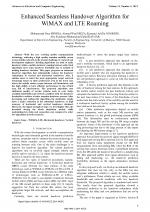| 4/2014 - 2 |
Enhanced Seamless Handover Algorithm for WiMAX and LTE RoamingHINDIA, M. N. |
| View the paper record and citations in |
| Click to see author's profile in |
| Download PDF |
Author keywords
WiMAX, LTE, horizontal handover, vertical handover
References keywords
networks(13), vertical(9), heterogeneous(8), wimax(6), mobile(6), decision(6), technology(4), prediction(4), network(4)
Blue keywords are present in both the references section and the paper title.
About this article
Date of Publication: 2014-11-30
Volume 14, Issue 4, Year 2014, On page(s): 9 - 14
ISSN: 1582-7445, e-ISSN: 1844-7600
Digital Object Identifier: 10.4316/AECE.2014.04002
Web of Science Accession Number: 000348772500002
SCOPUS ID: 84921655435
Abstract
With the ever evolving mobile communication technology, achieving a high quality seamless mobility access across mobile networks is the present challenge to research and development engineers. Existing algorithms are used to make handover while a mobile station is roaming between cells. Such algorithms have some handover instability due to method of making handover decision. This paper proposes an enhanced handover algorithm that substantially reduces the handover redundancy in vertical and horizontal handovers. Also, it enables users to select the most appropriate target network technology based on their preferences even in the worst case where the mobile station roams between cell boundaries, and has high ability to have efficient performance in the critical area full of interferences. The proposed algorithm uses additional quality of service criteria, such as cost, delay, available bandwidth and network condition with two handover thresholds to achieve a better seamless handover process. After developing and testing this algorithm, the simulation results show a major reduction in the redundant handover, so high accuracy of horizontal and vertical handovers obtained. Moreover, the signal strength is kept at a level higher than the threshold during the whole simulation period, while maintaining low delay and connection cost compared to other two algorithms in both scenarios. |
| References | | | Cited By |
Web of Science® Times Cited: 2 [View]
View record in Web of Science® [View]
View Related Records® [View]
Updated today
SCOPUS® Times Cited: 4
View record in SCOPUS® [Free preview]
View citations in SCOPUS® [Free preview]
[1] A New Effective Strategy for User Association in Heterogeneous Networks, Aziz, Layla, El Gourari, Abdelali, Achki, Samira, International Journal of Sensors, Wireless Communications and Control, ISSN 2210-3279, Issue 3, Volume 13, 2023.
Digital Object Identifier: 10.2174/2210327913666230601153113 [CrossRef]
[2] State of Art: Vertical Handover Decision Schemes in Next-Generation Wireless Network, Malathy, E. M., Muthuswamy, Vijayalakshmi, Journal of Communications and Information Networks, ISSN 2096-1081, Issue 1, Volume 3, 2018.
Digital Object Identifier: 10.1007/s41650-018-0009-2 [CrossRef]
[3] Ubiquity of Wi-Fi: Crowdsensing Properties for Urban Fingerprint Positioning, LECA, C. L., Advances in Electrical and Computer Engineering, ISSN 1582-7445, Issue 4, Volume 17, 2017.
Digital Object Identifier: 10.4316/AECE.2017.04016 [CrossRef] [Full text]
[4] An efficient multicriteria‐based vertical handover decision‐making algorithm for heterogeneous networks, Satapathy, Pratyashi, Mahapatro, Judhistir, Transactions on Emerging Telecommunications Technologies, ISSN 2161-3915, Issue 4, Volume 33, 2022.
Digital Object Identifier: 10.1002/ett.4409 [CrossRef]
Disclaimer: All information displayed above was retrieved by using remote connections to respective databases. For the best user experience, we update all data by using background processes, and use caches in order to reduce the load on the servers we retrieve the information from. As we have no control on the availability of the database servers and sometimes the Internet connectivity may be affected, we do not guarantee the information is correct or complete. For the most accurate data, please always consult the database sites directly. Some external links require authentication or an institutional subscription.
Web of Science® is a registered trademark of Clarivate Analytics, Scopus® is a registered trademark of Elsevier B.V., other product names, company names, brand names, trademarks and logos are the property of their respective owners.
Faculty of Electrical Engineering and Computer Science
Stefan cel Mare University of Suceava, Romania
All rights reserved: Advances in Electrical and Computer Engineering is a registered trademark of the Stefan cel Mare University of Suceava. No part of this publication may be reproduced, stored in a retrieval system, photocopied, recorded or archived, without the written permission from the Editor. When authors submit their papers for publication, they agree that the copyright for their article be transferred to the Faculty of Electrical Engineering and Computer Science, Stefan cel Mare University of Suceava, Romania, if and only if the articles are accepted for publication. The copyright covers the exclusive rights to reproduce and distribute the article, including reprints and translations.
Permission for other use: The copyright owner's consent does not extend to copying for general distribution, for promotion, for creating new works, or for resale. Specific written permission must be obtained from the Editor for such copying. Direct linking to files hosted on this website is strictly prohibited.
Disclaimer: Whilst every effort is made by the publishers and editorial board to see that no inaccurate or misleading data, opinions or statements appear in this journal, they wish to make it clear that all information and opinions formulated in the articles, as well as linguistic accuracy, are the sole responsibility of the author.





